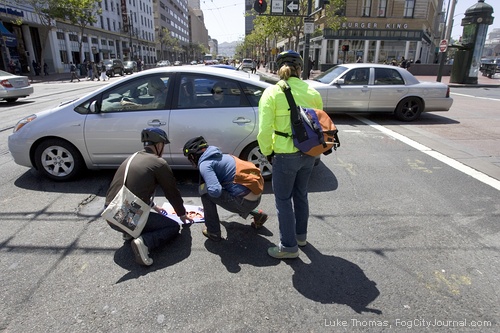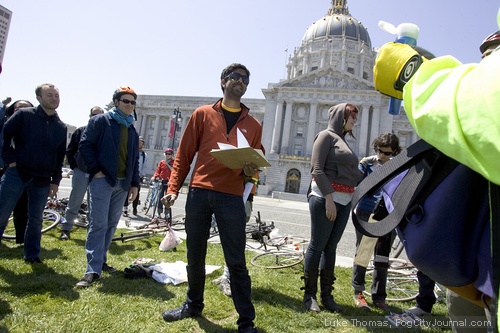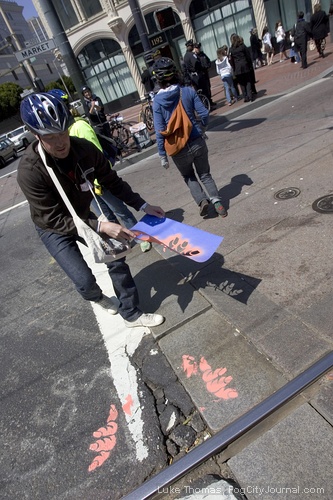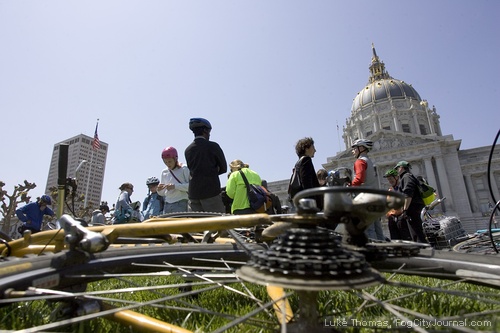
Members of the San Francisco Bicycle Coalition tagged potholes and dangerous road hazards
along Market Street Saturday in an effort to accelerate City pothole maintenance.
Photos by Luke Thomas
By Luke Thomas
April 22, 2008
Members of the San Francisco Bicycle Coalition roamed San Francisco’s bumpiest streets Saturday to tag potholes the group says present dangerous road conditions for cyclists.
Dubbed “Attack of the Crater Invaders,” cyclists convened in front of City Hall for a briefing before teams fanned out across the city in search of potholes and road hazards.
Armed with non-permanent spray paint and stencils, the coalition aims to accelerate the time it takes to fix potholes by tagging pavement hazards and calling them in to the city’s 3-1-1 service which immediately dispatches the information to the Department of Public Works (DPW).
“The San Francisco Bicycle Coalition has been working hard to improve the street quality for cyclists,” SFBC spokesperson Neil Patel told Fog City Journal during the press conference.

Neil Patel coordinates a briefing in front of City Hall
before sending out teams to identify and tag potholes.
“We all know there are potholes and other hazardous conditions on the road and they are a real danger to cyclists,” Patel added.
Though San Francisco has been designated a Gold level ‘Bike-Friendly Community’ by the League of American Bicyclists, a 2006 Report Card survey conducted by the SFBC rated San Francisco a “B-” in overall satisfaction. Satisfaction with pavement quality earned a “D+”, the survey’s lowest grade.
Potholes negatively impact both motorists and cyclists alike. For motorists, potholes reduce the life expectancy of suspension systems and tires leading to frequent and costly repairs. For cyclists, potholes can destabilize rides and cause preventable injurious accidents.
As many as 10 percent of the 1,151 respondents to the SFBC Report Card survey reported crashes directly related to potholes and road hazards, according to SFBC Executive Director Leah Shahum.
According Department of Public Works (DPW) communications spokesperson Christine Falvey, the department repaired 18,204 roadway defects in fiscal year 2006/7 and 11,000 defects so far in 2008.
“This fiscal year, DPW will have spent $36.4 million on its roadway resurfacing program and public works will have paved more than 300 blocks by the end of the fiscal year,” Falvey responded to Fog City Journal inquiry.
A separate capital budget helps to repair individual potholes, Department of Public Works Director Ed Reiskin said.
“Our pothole program is primarily funded through the city’s capital budget,” Reiskin reported. “For fiscal year 2007-08 (July 2007 through June 2008), we have $1.68 million for this program, which essentially funds two crews plus materials (asphalt).”
“By far the worst area in the city for potholes is in the Soma/Market Street area,” Patel reported, “but there are many potholes all over the city.”
Patel added that DPW has been “very responsive and helpful” in filling potholes as a result of SFBC’s assistance in identifying road hazards.





 The Hunger Site
The Hunger Site
April 24, 2008 at 9:39 am
“In a way that is safe and sustainable ” — Marc, make your proposal. How do other cities do this? I am not being sarcastic here, although I have been known to stoop at least to satire.
April 24, 2008 at 7:52 am
Look, the east side of the city takes the lions share of auto load, from commuters and, most importantly, from the commercial activity that generates city revenues.
The city takes those tax dollars we generate and uses them to keep the residential neighborhoods well kept and clean.
Instead of treating a structural cancer with band aids and aspirin, if the SFBC were doing its job, it would build a coalition to demand that the city maintain its simple capital systems in a way that is safe and sustainable.
But the SFBC was party to a proposed bond measure in 2003 which, get this, would have put the city 300m or so into hock on 30 year bonds to cover a slim fraction of street repair arrears with pavement that would last for only 20 years at best.
Could you imagine how much fun it would have been from 2023-2033 reminiscing about what good streets we had for those 20 years are we were still stuck paying down the last 10 years of bond debt and at twice the cost of fixing the streets due to interest burden?
Coming next, the SFBC invents a neutral gear for bicycles so that we can all be stuck in it.
-marc
April 23, 2008 at 9:43 pm
While I agree with Marc that fixing potholes is ideally the job of paid city employees, I think this activity — going out a marking potholes so that they are very visible to bicyclists — is one of the best things that the San Francisco Bicycle Coalition does to make the city more bikable. It has probably spared me a few scrapes, myself. I look forward to participating in future actions, and in fact, know exactly where the potholes are along my routine routes from the Richmond District to downtown and elsewhere.
Thanks to FCJ for covering this action.
The other activity that I really want the bike coalition to work on, which I think would also increase bicycling, is the completion of the citywide bike network — a future story for FCJ.
April 23, 2008 at 2:41 pm
The SFBC has been trumpeting this project for some time. The white paint has been on potholes for so long that its worn off.
We pay taxes so that city employees can keep up on matters like these. The City has no comprehensive plan to keep its streets capitalized to check wear and tear.
Streets are the simplest of capital systems, their rates of depreciation are utterly predictable. After Dianne Feinstein bled the streets dry for other projects, the City has never caught up with the backlog.
Maybe Newsom sees the Fieinstein route as his ticket to the US Senate?
-marc
April 22, 2008 at 12:55 pm
Right on! I support the San Francisco Bicycle Coalition 100% with this effort. Potholes and large cracks in the road also pose a real hazard to pedestrians.
Crossing (at the crosswalk, mind you) at Mason at Eddy Streets awhile back, my shoe went sideways into a crack in the asphalt. I fell down face-first and badly scrapped my hand and knee. Fortunately, there were no cars coming and, ironically, I was on my way to the doctor’s office. The nurse there patch me up, but I my pants were torn and I was walking with a noticeable limp for days.